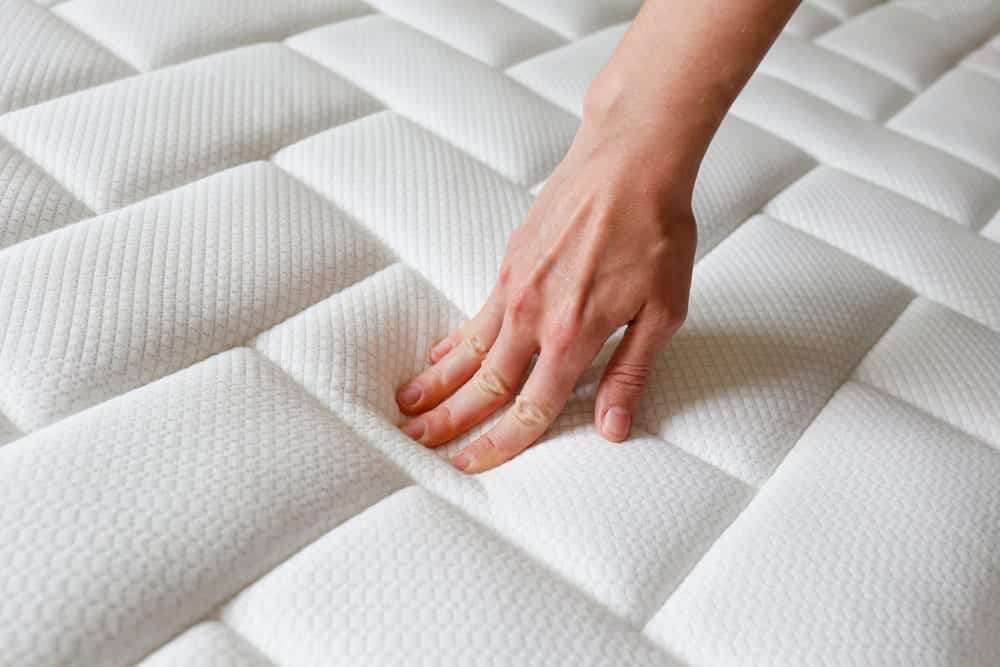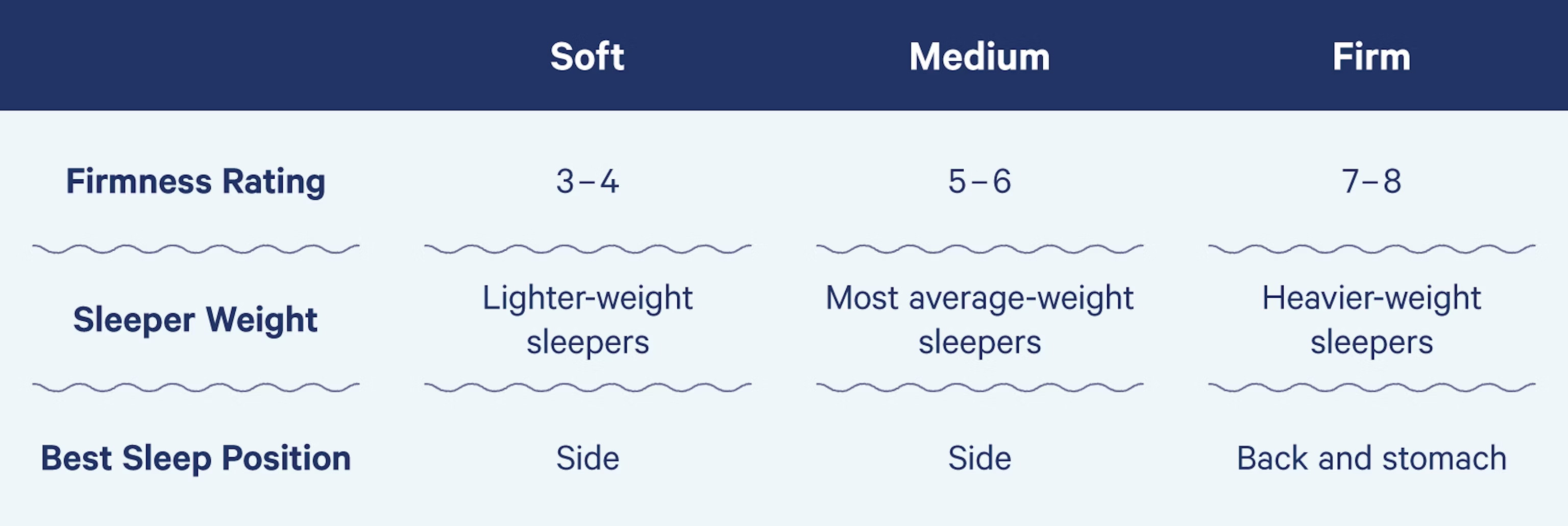When shopping for a new mattress, one of the most important factors to consider is firmness. The level of firmness can greatly affect your comfort and quality of sleep. But with so many options available, it can be overwhelming to know which firmness is right for you. That’s where the firmness scale comes in. The firmness scale is a rating system used by mattress manufacturers to indicate the level of firmness of their products. It typically ranges from 1 to 10, with 1 being the softest and 10 being the firmest. This scale can be a helpful tool in determining which mattress is best suited for your needs. Keep in mind that the firmness scale is subjective and can vary between brands. However, understanding this scale can give you a general idea of what to expect when purchasing a new mattress.1. Firmness Scale for Mattresses
One of the most common questions when it comes to buying a mattress is “how do I choose the right firmness?” The answer is not a one-size-fits-all solution. It ultimately depends on your personal preference and sleeping habits. For those who prefer a softer feel, a mattress with a firmness level of 1-3 is recommended. These mattresses provide more cushion and sinkage, making them ideal for side sleepers. On the other hand, back and stomach sleepers may prefer a firmer mattress (around 7-9) for better support and alignment. If you are a combination sleeper, meaning you switch positions throughout the night, a medium firmness (around 4-6) may be the best option. This allows for a balance of comfort and support, catering to different sleeping styles.2. How to Choose the Right Firmness for Your Mattress
Now let’s take a closer look at the different levels of firmness commonly found in mattresses. Level 1: Extra Soft – This level is typically reserved for specialty mattresses such as memory foam or latex. It offers maximum pressure relief and is ideal for those who prefer a “sleeping on a cloud” sensation. Level 2-3: Soft – Mattresses in this range are still on the softer side but with a bit more support. They are great for side sleepers or those with chronic pain who need additional cushioning. Level 4-6: Medium – This is the most common firmness level and caters to a wide range of sleeping styles. It offers a balance of comfort and support, making it a popular choice for many. Level 7-9: Firm – These mattresses provide a solid and sturdy surface, perfect for back and stomach sleepers who need more support to maintain proper spinal alignment. Level 10: Extra Firm – This level is the most rigid and is typically found in orthopedic or medical mattresses designed for those with severe back problems.3. Understanding the Different Levels of Firmness in Mattresses
The debate between firm and soft mattresses has been ongoing for years. But the truth is, neither is inherently better than the other. It all comes down to personal preference and your specific needs. Soft mattresses offer more contouring and pressure relief, making them ideal for those with joint pain or pressure points. They also tend to be better for lighter weight individuals. On the other hand, firm mattresses offer more support and are better suited for heavier individuals or those with back pain. It’s important to note that a mattress can be too firm or too soft, and that’s why finding the right level of firmness for your body type and sleeping style is crucial for a good night’s rest.4. Firm vs. Soft Mattresses: Which is Right for You?
As mentioned earlier, your sleeping position plays a significant role in determining the right firmness for your mattress. Let’s take a look at the recommended firmness levels for each sleeping position: Side Sleepers – As mentioned before, side sleepers may benefit from a softer mattress (level 1-3) to provide adequate cushioning for the shoulders and hips. Back Sleepers – Back sleepers typically do best with a medium-firm mattress (level 4-6) that offers enough support to keep the spine aligned without causing pressure points. Stomach Sleepers – Stomach sleepers need a firmer mattress (level 7-9) to prevent their hips from sinking too far into the mattress and causing lower back pain. Combination Sleepers – As a combination sleeper, it’s essential to find a mattress with medium firmness (level 4-6) that can accommodate different sleeping positions throughout the night.5. The Best Firmness Level for Different Sleeping Positions
Now that you have a better understanding of the different levels of firmness, here are some tips to help you find the perfect firmness for your mattress: 1. Consider your body type and weight – As mentioned before, your weight can affect the level of firmness you need. Lighter individuals may prefer a softer mattress, while heavier individuals may need a firmer one. 2. Take into account any health conditions or injuries – If you have chronic pain or injuries, you may benefit from a softer mattress that offers more pressure relief. 3. Test it out – It’s always best to test out a mattress before making a purchase. Lie down on different levels of firmness and see which one feels the most comfortable and supportive for your body.6. Finding the Perfect Firmness for Your Mattress: Tips and Tricks
The terms “firmness” and “support” are often used interchangeably, but they are not the same thing. Firmness refers to the surface feel of the mattress, while support refers to how well the mattress can keep your spine aligned. A mattress can have a high level of firmness, but if it does not provide proper support, it can lead to discomfort and pain. That’s why it’s essential to find a mattress that offers both the right level of firmness and support for your body.7. Firmness vs. Support: What’s the Difference?
When shopping for a new mattress, it’s essential to test it out before making a purchase. Here are a few ways to determine the firmness of a mattress: 1. Lie down on your back and see how your spine feels – If your spine is in a neutral position, it’s a good indication that the mattress has the right level of firmness for back sleepers. 2. Test the sinking feeling – If you prefer a softer mattress, you may want to see how much you sink into the mattress. If you can sink in comfortably without feeling like you’re bottoming out, it may be the right level of softness for you. 3. Consider the materials – The type of material used in a mattress can also affect the level of firmness. For example, memory foam tends to be softer, while innerspring mattresses offer more firmness.8. How to Test the Firmness of a Mattress Before Buying
Like most things, there are pros and cons to different levels of firmness in mattresses. Here are a few to consider: Soft Mattresses (level 1-3) Pros: Pressure relief, good for side sleepers, conforms to body shape Cons: May not provide enough support, can be too soft for some individuals Medium-Firm Mattresses (level 4-6) Pros: Balanced support and comfort, good for combination sleepers Cons: May not provide enough cushioning for side sleepers or enough support for heavier individuals Firm Mattresses (level 7-9) Pros: Good for back and stomach sleepers, provides proper support for heavier individuals Cons: May be too firm for some, can cause pressure points for those with joint pain9. The Pros and Cons of Different Firmness Levels in Mattresses
If you find that your mattress is too firm or too soft, you may be wondering if it is possible to adjust the firmness. The answer is yes, but it depends on the type of mattress you have. Some mattresses, like airbeds or hybrid mattresses, come with adjustable firmness options, allowing you to customize it to your liking. Other mattresses, such as memory foam or innerspring, do not have this option. If you have a non-adjustable mattress, you can try adding a mattress topper to change the level of firmness. However, keep in mind that this may not have the same effect as an adjustable mattress. In conclusion, the level of firmness in a mattress is a crucial factor to consider for a good night’s sleep. Understanding the firmness scale and how it relates to your personal preferences and sleeping habits can help you make an informed decision when purchasing a new mattress. Remember to also consider the materials, test it out, and don’t be afraid to make adjustments if needed. With the right level of firmness, you can wake up feeling rested and refreshed every morning.10. Adjusting the Firmness of Your Mattress: Is it Possible?
The Importance of Selecting the Right Firmness Level for Your Mattress

Why Firmness Matters
The Different Firmness Levels
 There is no one-size-fits-all when it comes to
mattress firmness
. It is a personal preference, and what may be comfortable for one person may not be for another. Generally,
mattresses
are categorized into three levels of firmness - soft, medium, and firm.
Soft mattresses
provide a plush and sink-in feeling, while
medium mattresses
offer a balance between support and comfort.
Firm mattresses
are the most supportive and provide a more rigid surface.
There is no one-size-fits-all when it comes to
mattress firmness
. It is a personal preference, and what may be comfortable for one person may not be for another. Generally,
mattresses
are categorized into three levels of firmness - soft, medium, and firm.
Soft mattresses
provide a plush and sink-in feeling, while
medium mattresses
offer a balance between support and comfort.
Firm mattresses
are the most supportive and provide a more rigid surface.
The Right Firmness for You
 Selecting the right
mattress firmness
is crucial for a good night's sleep. If your mattress is too soft, it can cause your body to sink, resulting in back or neck pain. On the other hand, a
firm mattress
may put too much pressure on your joints, leading to discomfort and restless sleep. It is essential to consider your sleeping position and body weight when choosing the
firmness level of your mattress
. Side sleepers may prefer a softer mattress to relieve pressure on their hips and shoulders, while back and stomach sleepers may benefit from a firmer mattress for proper spinal alignment.
Selecting the right
mattress firmness
is crucial for a good night's sleep. If your mattress is too soft, it can cause your body to sink, resulting in back or neck pain. On the other hand, a
firm mattress
may put too much pressure on your joints, leading to discomfort and restless sleep. It is essential to consider your sleeping position and body weight when choosing the
firmness level of your mattress
. Side sleepers may prefer a softer mattress to relieve pressure on their hips and shoulders, while back and stomach sleepers may benefit from a firmer mattress for proper spinal alignment.
The Impact on Your Health
 Sleeping on the wrong
firmness level of mattress
can have negative effects on your health. Chronic back pain, neck pain, and poor posture are just some of the potential consequences. Additionally, inadequate support can disrupt your sleep, leading to fatigue, irritability, and decreased productivity. On the other hand, the right
mattress firmness
can improve your sleep quality, reduce pain, and enhance your overall well-being.
In conclusion, selecting the right
firmness level for your mattress
is crucial for a comfortable and healthy sleep. Consider your sleeping position, body weight, and personal preferences when making your decision. Investing in a high-quality
mattress
with the perfect
firmness level
can greatly improve your sleep and overall quality of life. Don't overlook this essential element in your house design - your body will thank you.
Sleeping on the wrong
firmness level of mattress
can have negative effects on your health. Chronic back pain, neck pain, and poor posture are just some of the potential consequences. Additionally, inadequate support can disrupt your sleep, leading to fatigue, irritability, and decreased productivity. On the other hand, the right
mattress firmness
can improve your sleep quality, reduce pain, and enhance your overall well-being.
In conclusion, selecting the right
firmness level for your mattress
is crucial for a comfortable and healthy sleep. Consider your sleeping position, body weight, and personal preferences when making your decision. Investing in a high-quality
mattress
with the perfect
firmness level
can greatly improve your sleep and overall quality of life. Don't overlook this essential element in your house design - your body will thank you.






























































































:max_bytes(150000):strip_icc()/770_SantaYnez_FamilyRoom_011-82636c6ea1df487eb70fa8ed313a6369.jpg)

